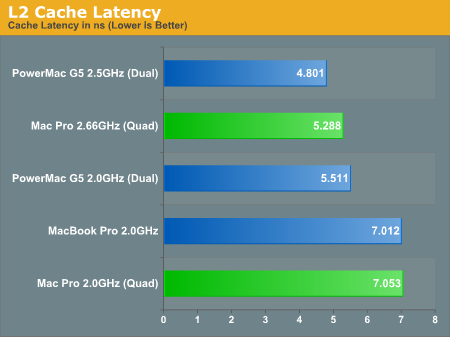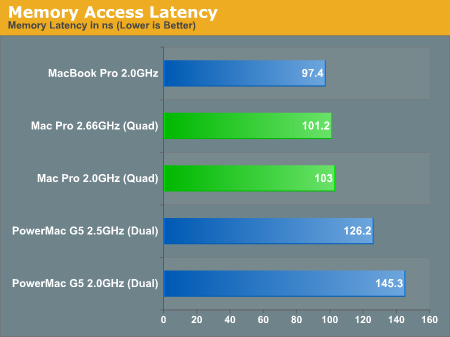Apple's Mac Pro - A True PowerMac Successor
by Anand Lal Shimpi on August 16, 2006 12:27 PM EST- Posted in
- Mac
Memory Performance
We'll start off our look at the Mac Pro's performance with some low level memory tests, since arguably the most controversial aspect of the Mac Pro is its use of Fully Buffered DIMMs. For more information about FB-DIMMs be sure to read our original article on the Mac Pro.

The G5 had a very quick 12-cycle L2 cache, which gives it a slight performance advantage compared to the 14-cycle L2 of the Xeons in the Mac Pro. Access latency is only one part of the puzzle however, as the G5s benchmarked here only had a 512KB L2 cache (the G5 later got an upgrade to a 1MB cache) while the Xeons in the Mac Pro have a 4MB L2 cache per chip. The G5 had a slightly faster L2, but you can reach higher clocks with the Xeon thus minimizing the effective latency and you can fit more data into the larger L2.

And here we see the real killer with FB-DIMMs; although the Mac Pro boasts lower latency memory accesses than the PowerMac G5, it actually takes longer to access main memory than the Core Duo processor in the MacBook Pro. This is much worse than it sounds once you take into account the fact that the MacBook Pro features a 667MHz FSB compared to the 1333MHz FSB (per chip) used in the Mac Pro.
We can further put things in perspective by looking at memory latency under Windows XP, compared to Intel's Core 2 processor. Remember that the Core 2 is identical to the Xeons in the Mac Pro, the difference being that the chipset uses regular DDR2 memory instead of DDR2-667 FB-DIMMs. Note that for our Core 2 system in the comparison below we ran the memory at DDR2-667 at 5-5-5-15 timings as well as DDR2-800 at 4-4-4-12 to provide apples-to-apples as well as apples-to-fastest comparisons.
| CPU | Everest |
CPU-Z 1.35 (8192KB, 256-byte stride) | Everest READ | Everest WRITE |
| Apple Mac Pro 2.66GHz (DDR2-667 FB-DIMM Quad Channel) | 100 ns | 87.4 ns | 4292 MB/s | 3759 MB/s |
| Apple Mac Pro 2.66GHz (DDR2-667 FB-DIMM Dual Channel) | 105.8 ns | 92.3 ns | 4141 MB/s | 3096 MB/s |
| Intel Core 2 Duo E6700 2.66GHz (DDR2-800 4-4-4-12 Dual Channel) | 59.9 ns | 52.8 ns | 7413 MB/s | 4859 MB/s |
| Intel Core 2 Duo E6700 2.66GHz (DDR2-667 5-5-5-15 Dual Channel) | 68.9 ns | 59 ns | 6782 MB/s | 4858 MB/s |
It's not Apple's fault, but FB-DIMMs absolutely kill memory latency; even running in quad channel mode, the FB-DIMM equipped Mac Pro takes 45% more time to access memory than our DDR2 equipped test bed at the same memory frequency. Things don't get any prettier when we look at memory bandwidth either.
Remember the overhead we were worried about with the serialization of parallel memory requests? With four FBD channels, the best we're able to see out of the Mac Pro is 4.292GB/s, compared to the 6.782GB/s of bandwidth our dual channel Core 2 testbed is able to provide. The efficiency table below says it all:
| CPU | Peak Theoretical Bandwidth |
Everest READ | Efficiency |
| Apple Mac Pro 2.66GHz (DDR2-667 FB-DIMM Quad Channel) | 21.3GB/s | 4.292GB/s | 20% |
| Apple Mac Pro 2.66GHz (DDR2-667 FB-DIMM Dual Channel) | 10.67GB/s | 4.141GB/s | 38.8% |
| Intel Core 2 Duo E6700 2.66GHz (DDR2-800 4-4-4-12 Dual Channel) | 12.8GB/s | 7.413GB/s | 57.9% |
| Intel Core 2 Duo E6700 2.66GHz (DDR2-667 5-5-5-15 Dual Channel) | 10.67GB/s | 6.782GB/s | 63.6% |
FB-DIMMs are simply not good for memory performance; the added capacity allowed by having 8 FB-DIMM slots on the Mac Pro had better be worth it, because if Apple were to release a Core 2 based Mac chances are that it could give the Mac Pro a run for its money in a number of memory sensitive tasks.










96 Comments
View All Comments
DigitalFreak - Wednesday, August 16, 2006 - link
Is there a 64bit version of OS X for the Intel platform? I didn't think there was, considering that until now all of the Intel Macs have only had 32bit processors.kelmon - Thursday, August 17, 2006 - link
Depends on what you mean by 64-bit. OS X has, I believe, had a 64-bit UNIX layer since 10.3 (I don't think it was introduced with 10.4) but the only applications that can take advantage of this are command-line tools. Leopard will introduce 64-bit everywhere but I'm still struggling to find a reason why that will impact me in a good way. That said, the new Mac will have a 64-bit processor so that I can feel future-proof.Pirks - Wednesday, August 16, 2006 - link
Good question. I don't know, maybe OS X on those Mac Pros is patched to 64-bit or something.. if not than I should shut up and wait till Leopard.Snuffalufagus - Wednesday, August 16, 2006 - link
it should factor in at least a 25% - 35% discount code on the Dell :).I have never bought anything off the Dell site without getting a substantial discount from a current promotion.
trivik12 - Wednesday, August 16, 2006 - link
Does Dell offer 25-35% off for Dell Precision Workstation?MrPIppy - Wednesday, August 16, 2006 - link
The last generation of Power Mac G5s also had dual GigE ports: http://www.apple.com/powermac/specs.html">Apple's G5 specs pageOne difference though, the G5s (and the GigE G4s before them) used Broadcom 57xx chips for Ethernet, while the Mac Pro now uses an Intel 8254x chip.
Josh7289 - Wednesday, August 16, 2006 - link
But what is so good about Macs? Why would I want a Mac instead of a PC? What can a Mac offer me that a PC can't? I don't like trolling, but I seriously am asking these questions and want to know what the answers are.phaxmohdem - Wednesday, August 16, 2006 - link
I used to be a mac hater because All the macs I've ever used truely were Pieces of $h!t. Old single cpu G4 towers with no Hard Drive Space or RAM, and way too much student crap spread on them. HOWEVER recently I had the pleasure of using a REAL mac (Quad G5) for a video project, and it made me think of macs a little differently. Plenty fast, and stable. My biggest problems were learning all the new Mac hot keys and keyboard shortcuts.. but once you master those you'll fly on the mac. (Some of Macs shortcuts still seem pretty stupid and complex to me though).However I serioualy don't understand the keyboard and mouse that Apple gives their cusotomers... The new mighty mouse is an improvement, but still an uncomfortable POS to me. Ditto for the mushy fugly keyboard that is standard. I've found that a proper Logitech (or similar) Kybd/Mouse combo makes the mac experience feel 10x better. (One more side-gripe... OS X does not have adjustments for mouse acceleration, and for me the stock acceleration speeds are wretched and piss me off... Hopefully this is something to be updated in the next release of the OS)
So, moral of my story is... if you're going to Mac it up, do it right with proper input devices and some decent specs, and you'll have an enjoyable experience under OS X. I personally still choose Windows for its versatility w/ software and hardware... but to each his own.
Maury Markowitz - Thursday, August 17, 2006 - link
Agree. I find it somewhat ironic that the only MS products I really like are their keyboards, mice, and joysticks. What's particularily maddening is that Apple used to, years ago, make the best keyboard money could buy. Seriously, solid as a rock and typing feel you'd kill for. Now they peddle crap that looks nice. Not good.timelag - Thursday, August 17, 2006 - link
Apple used to, years ago, make the best keyboard money could buy.Ah yes, the extended keyboard II. Better even than the famous IBM and Sun keyboards of yore. If it weren't for my Kinesis (the One True ergo keyboard), I'd be using mine through an ADB to USB connector.